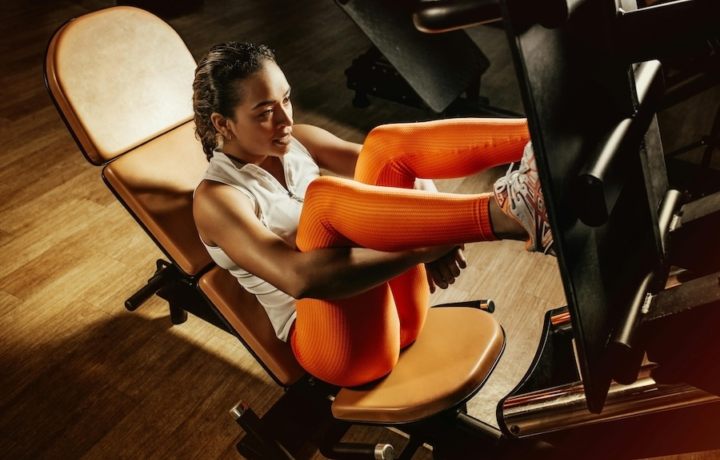Exercise
Bent Knee Glute Kickback

Bent Knee Glute Kickback
How to Perform
- Position yourself on all fours with your hands directly under your shoulders and knees under your hips, keeping your back flat and core engaged. Breathe naturally and maintain a neutral spine position.
- Choose one leg to work with and bend it to a 90-degree angle, keeping your foot flexed and knee pointing down. Stabilize your position by pressing firmly through your supporting limbs.
- Engage your core muscles and squeeze your glutes as you prepare to lift the working leg. Maintain even weight distribution through your supporting hands and knee.
- Exhale as you push your bent leg up and back until your thigh is parallel to the floor and your foot is pointing toward the ceiling. Keep your hips square to the ground to isolate the glute muscles.
- Hold the contracted position at the top for 1-2 seconds, focusing on the squeeze in your glute muscles. Maintain a stable torso without rotating your hips or arching your lower back.
- Inhale as you slowly lower your leg back to the starting position without touching your knee to the ground. Control the descent to maintain tension in the working muscles.
- Repeat the movement for the prescribed number of repetitions before switching to the other leg. Maintain consistent breathing throughout each repetition.
- To increase intensity, you can add ankle weights or resistance bands just above the knee of the working leg. Ensure proper form is maintained when adding resistance.
Important information
- Keep your abdominals engaged throughout the entire exercise to protect your lower back from excessive arching.
- Focus on using your glute muscles to power the movement, not your lower back or hamstrings.
- Maintain a neutral neck position by gazing at a spot on the floor about a foot in front of you rather than looking up or down.
- If you experience any knee discomfort, try placing a folded mat under your supporting knee for additional cushioning.

Bent Knee Glute Kickback
Exercise Details
Primary Muscles
Muscle Groups
Mechanic
Risk Areas
Built for progress
Take the guesswork out of training
Create personalized AI-powered workout plans that evolve with you. Train smarter, track every rep and keep moving forward, one workout at a time.






The Bent Knee Glute Kickback stands as a targeted isolation exercise that has earned its place in the arsenal of intermediate fitness enthusiasts looking to develop stronger, more defined glutes and hamstrings. This movement has gained popularity in bodybuilding circles and rehabilitation programs alike for its ability to effectively engage the posterior chain without placing excessive stress on the lower back. Unlike compound movements that distribute tension across multiple muscle groups, the bent knee variation creates a more concentrated stimulus directly on the gluteus maximus while simultaneously recruiting the hamstrings as secondary movers.
The bent knee position is particularly valuable as it reduces hamstring involvement compared to straight-leg variations, allowing for more precise glute targeting: something essential for both aesthetic development and functional strength. For those in recovery phases or dealing with certain lower back conditions, this exercise provides a safer alternative to more demanding hip extension movements. The controlled nature of the kickback makes it ideal for rehabilitation protocols while still delivering enough resistance to stimulate muscle growth when properly loaded.
The exercise becomes especially effective when incorporated into high-repetition finisher sets designed to create metabolic stress in the glutes. Strength athletes increasingly recognize the value of isolated glute work for improving performance in compound lifts. The bent knee glute kickback helps address posterior chain weaknesses that might limit progress in deadlifts, squats, and Olympic movements. By strengthening these muscles in isolation, athletes often find improved power generation and stability in their primary lifts. When programmed strategically: typically for 3-4 sets of 12-15 repetitions, this exercise proves valuable for hypertrophy-focused training splits and as an activation movement before heavier lifting sessions. The mind-muscle connection developed through this focused movement translates to better recruitment patterns during more complex exercises, making it not just an aesthetic builder but a performance enhancer for intermediate lifters seeking balanced posterior chain development.
FAQ - Bent Knee Glute Kickback
The Bent Knee Glute Kickback primarily targets the gluteus maximus (main glute muscle) with secondary activation in the hamstrings. The bent knee position specifically increases glute isolation by reducing hamstring involvement compared to straight-leg variations.
Stand facing the cable machine with the ankle attachment secured, maintain a slight bend in your supporting leg, and keep your core engaged throughout the movement. Focus on driving the movement from your glutes rather than your lower back, and avoid arching or rounding your spine.
Add resistance using ankle weights, cable machines, or resistance bands for progressive overload. You can also increase time under tension by incorporating pulse reps at the top of the movement or slowing down the eccentric (lowering) phase of each repetition.
The Bent Knee Glute Kickback is generally safer for those with lower back issues compared to straight-leg variations, as it reduces lumbar stress. However, proper form is crucial—maintain a neutral spine, engage your core, and avoid overextending at the top of the movement to protect your lower back.
Include this exercise 2-3 times weekly for optimal glute development, typically programming 3-4 sets of 12-15 repetitions per side. You can use it as part of a dedicated lower body session or as an activation exercise before compound movements like squats and deadlifts.







